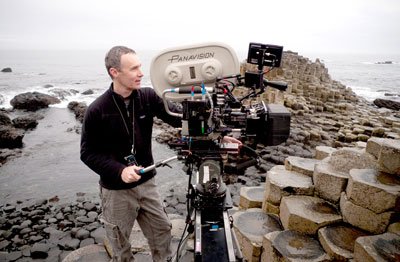CINEMATOGRAPHER SPOTLIGHT: TIM ORR
by Margot C. Lester
Like a lot of folks, Tim Orr bounced around after college, looking for a career that would stick.
“After working a series of really crappy jobs, I started to have an artistic awakening of sorts,†says Orr, the Hendersonville-born cinematographer of several great indie films and some of your favorite Eastbound & Down episodes. “I began to paint and write. Then I started to watch movies seriously. That’s when I thought that it was something that I wanted to do with my life.â€

So he decided on film school and was accepted at the N.C. School of the Arts in Winston-Salem. He was leaning toward writing/directing, but NCSA is structured like a conservatory, exposing students to all aspects of making films, regardless of their primary interests.
“When it came to camera and lighting, I discovered what I was most interested in, and I had a certain talent for it,†Orr admits. “I had no formal training in photography at all – I really didn’t understand the technical side, but what I had was instinct and an eye for framing and camera placement. The technical side of things fell into place after a bit of obsessive study.â€
Inspirations and influences
As part of that study, Orr discovered the work of still photographer William Eggleston, who’s credited with elevating color photography to an art form.
“He has the most amazing eye for telling a story with simple images,†Orr says. “I also appreciate and connect with his approach of finding beauty in ordinary subjects. He trusts his instincts, with beautiful, poetic results. That’s what I strive for: simplistic honesty in photography.â€
Many of the same things appeal to him in moving pictures. Orr was inspired by films like Butch Cassidy and the Sundance Kid, shot by Conrad Hall.
“It’s a film where the camera is an evocative tool in the storytelling – it seems to always be in the perfect place,†Orr explains. “Conrad Hall’s lighting is gutsy and naturalistic, and his day exterior work is exquisite. His use of the zoom, lens flares, widescreen composition – and his use of overexposure to temper color – played a very influential role in my development as a cinematographer.â€
Big screen
Orr’s first professional film was The Lesser Evil, an independent film shot in Winston-Salem in 1996, when he still had two more years of school to go. He was a day-playing grip – one of the people who maintain production equipment on the set.
He has collaborated with writer/director David Gordon Green on seven films, including 2000’s George Washington, which received multiple Independent Spirit Awards; 2003’s All the Real Girls, which won two Special Jury Prizes at Sundance; and 2004’s Undertow, which took three awards on the festival circuit.
“David and I share a similar vision and taste in filmmaking,†explains the Portland, Ore.-based cinematographer. “Early on, the first four movies especially, we found that it was a very easy partnership. I knew what he was going for in the performances and the tone of the film, and that allowed me to get into the skin of the movie in terms of the visual image. I would know where to put the camera and how to light the scene to underscore what was going on emotionally in the story. It has become a real shorthand, and an extremely rewarding collaboration.â€
Orr was also behind the camera for 2008’s Choke, an adaptation of the Chuck Palahniuk novel written and directed by former Chapel Hillian Clark Gregg (he and Gregg will team again on Trust Me, which begins shooting next month), and several comedies starring Seth Rogen, most recently 2009’s Observe & Report. Orr’s current project is called Seeking a Friend For the End of the World (with first-time director Lorene Scafaria), a film Orr describes as “a beautifully written love story set on the precipice of the end of the life as we know it.â€
Small screen
Though he loves the big screen, Orr relishes his work on Eastbound & Down (on which he also collaborated with Green) because it gave him more leeway to try new or unconventional things.
“We strayed from the conventional expectations of what a comedy should look like,†he explains. “It was approached much more as a drama than a comedy, with naturalistic lighting and a ’70s-flavored ‘Altmanesque’ style of camera movement. We exploited the use of the zoom lens and shot coverage in an unconventional manner, often with two moving cameras shooting an entire scene in one setup.â€
Like anyone who’s found his calling, Orr is as humble as he is happy.
“Everyday, I feel blessed,†he allows. “I feel blessed and thankful for a wonderful family and an exciting and rewarding career as a cinematographer. When I go to work, it doesn’t feel like work, because it is something that I love doing.â€